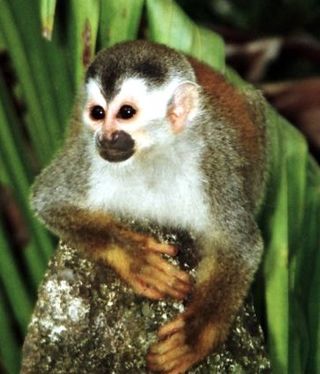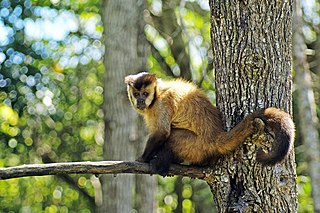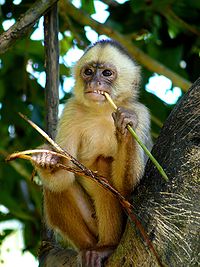
The capuchin monkeys are New World monkeys of the subfamily Cebinae. They are readily identified as the "organ grinder" monkey, and have been used in many movies and television shows. The range of capuchin monkeys includes some tropical forests in Central America and South America as far south as northern Argentina. In Central America, where they are called white-faced monkeys ("carablanca"), they usually occupy the wet lowland forests on the Caribbean coast of Costa Rica and Panama and deciduous dry forest on the Pacific coast.

The tufted capuchin, also known as brown capuchin, black-capped capuchin, or pin monkey, is a New World primate from South America and the Caribbean islands of Trinidad and Margarita. As traditionally defined, it is one of the most widespread primates in the Neotropics, but it has recently been recommended considering the black-striped, black and golden-bellied capuchins as separate species in a new genus, thereby effectively limiting the tufted capuchin to the Amazon basin and nearby regions. However, the large-headed capuchin (S. a. macrocephalus), previously defined as a distinct species, has been reclassified as a subspecies of the tufted capuchin, expanding its range east to Peru and Ecuador and south to Bolivia.

The black-striped capuchin, also known as the bearded capuchin, is a New World monkey in the family Cebidae. They can be found in northern and central Brazil. These capuchins mostly live in dry forests, and savannah landscapes between the Rio Araguaia and the Rio Grande. Known for its tool use, the black-striped capuchin has been shown to use tools in a wide variety of situations, ranging from using rocks for nut cracking to using sticks for digging. They were, until recently, considered a subspecies of the tufted capuchin, but because of more research and insights, they are considered their own species by many.

The Central American squirrel monkey, also known as the red-backed squirrel monkey, is a squirrel monkey species from the Pacific coast of Costa Rica and Panama. It is restricted to the northwestern tip of Panama near the border with Costa Rica, and the central and southern Pacific coast of Costa Rica, primarily in Manuel Antonio and Corcovado National Parks.

Gracile capuchin monkeys are capuchin monkeys in the genus Cebus. At one time all capuchin monkeys were included within the genus Cebus. In 2011, Jessica Lynch Alfaro et al. proposed splitting the genus between the robust capuchin monkeys, such as the tufted capuchin, and the gracile capuchins. The gracile capuchins retain the genus name Cebus, while the robust species have been transferred to Sapajus.

The crested capuchin or robust tufted capuchin is a species of robust capuchin monkey. It is endemic to Brazil. It was formerly considered a subspecies of the black capuchin but is now considered by some to be a separate species.

Azaras's capuchin or hooded capuchin is a species of robust capuchin. It occurs in eastern Paraguay, southeastern Bolivia, northern Argentina, and Brazil, at Mato Grosso do Sul and Mato Grosso states, in Pantanal. Its habitat consists of subtropical, humid, semi-deciduous, gallery forests and forested regions of the Pantanals. Formerly, it was considered a subspecies of black-striped capuchin, according to Groves (2005) with the name Cebus libidinosus paraguayanus, but Silva Jr. (2001) considered it a separated species. They are considered as frugivores-insectivores which means that their diet mainly consists of a variety of fruits, seeds, arthropods, frogs, small mammals, etc.

The Colombian white-faced capuchin, also known as the Colombian white-headed capuchin or Colombian white-throated capuchin, is a medium-sized New World monkey of the family Cebidae, subfamily Cebinae. It is native to the extreme eastern portion of Panama and the extreme north-western portion of South America in western Colombia and northwestern Ecuador.

The brown weeper capuchin or Venezuelan brown capuchin is a species of gracile capuchin monkey endemic to Venezuela, although some sources also consider it to occur on Trinidad.

Humboldt's squirrel monkey is a species of squirrel monkey from Brazil, Colombia, Ecuador, Peru and Venezuela. It had previously been considered a subspecies of the common squirrel monkey, S. scuireus, but was elevated to full species status based on a genetic study by Carretero-Pinzón in 2009. A genetic study by Jessica Lynch Alfaro, et al indicated that the Ecuadorian squirrel monkey may be synonymous with Saimiri cassiquiarensis. As of 2018, the Ecuadorian squirrel monkey is generally regarded as a subspecies of Humboldt's squirrel monkey, S. cassiquiarensis macrodon.

The Guianan squirrel monkey is a species of squirrel monkey from Guiana, Venezuela and Brazil. S. sciureus formerly applied to Humboldt's squirrel monkey and Collins' squirrel monkey, but genetic research in 2009 and 2015 revealed that these are distinct species.

The Ecuadorian squirrel monkey is a type of squirrel monkey. It had been considered a subspecies of the Guianan squirrel monkey, Saimiri sciureus, but was elevated to a full species, S. macrodon, based on a 2009 study by Carretero-Pinzón, et al. Based on subsequent genetic research by Jessica Lynch Alfaro, et al it was again reclassified as a subspecies of Humboldt's squirrel monkey.
















